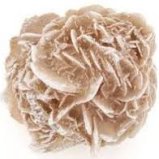
A desert rose is a mineral formation of barite, selenite, or gypsum. These minerals become impregnated with sand as they are forming and crystalizing and a rosette pattern forms. Some of these formations do highly resemble roses, however, their texture is grainy and rough and not at all smooth. Desert roses are used as specimen stones in display cases for rockhounds and collectors, as party favours, and large specimens can even be used as centerpeices. The most common use of these beautiful stones however is by placing them in potted plants or in the garden especially around roses to increase production and health of the plants.
The name "Desert Rose" is given to unusual roseate structures composed of either gypsum and sand or barite and sand. As the term would suggest, they are found in arid deserts — these include the Sahara, the Sonora Desert in Mexico, and those of the south-western United States. They form as a result of the evaporation of mineral rich solutions, with each of the "petals" being made up of individual crystals. These are usually orange or yellow, and are soft and transluscent, with an uneven fracture and a vitreous to pearly luster.
Properties:
1) A growth aid for plants.
2) A good luck charm.
3) A symbol for natures beauty and mystery.